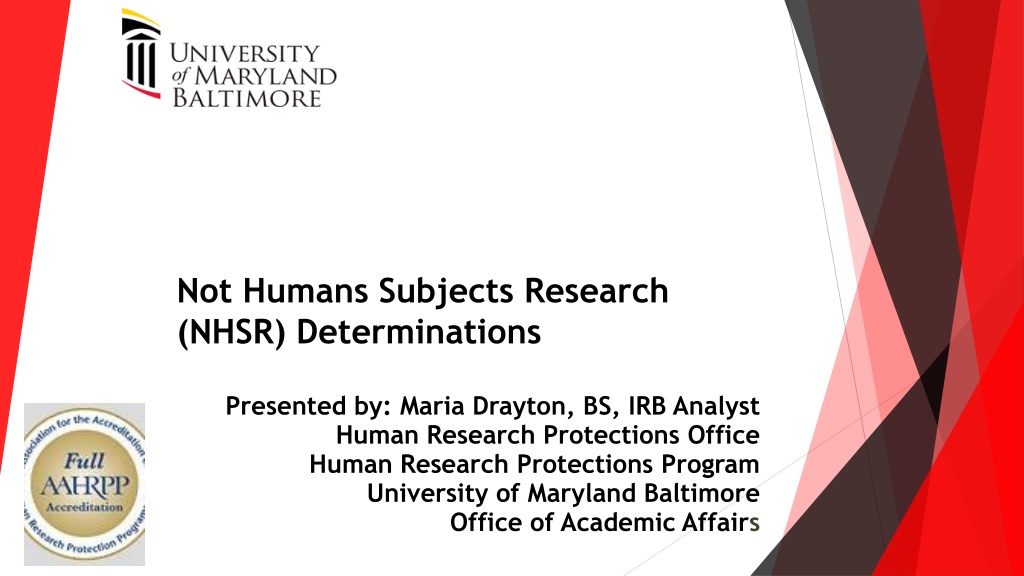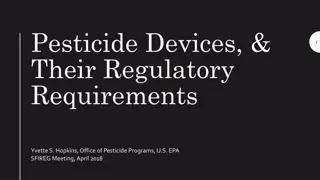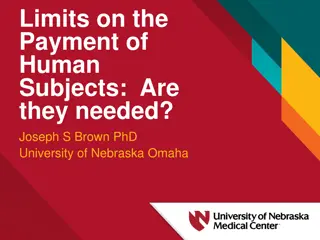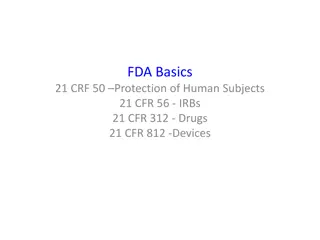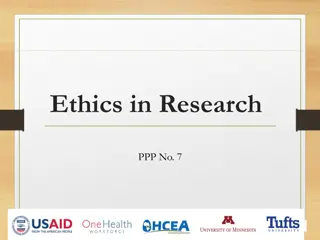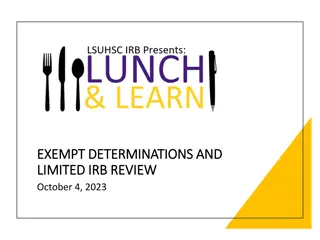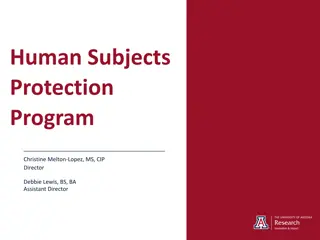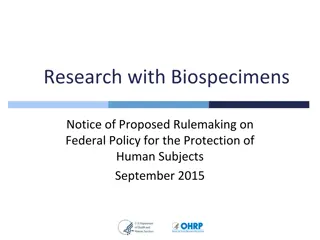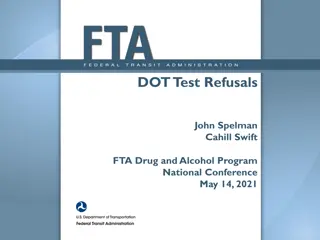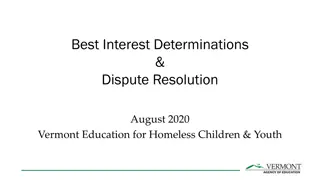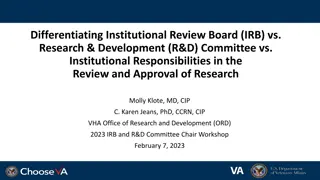Understanding Not Humans Subjects Research (NHSR) Determinations
Maria Drayton, an IRB Analyst at the University of Maryland, presents important information on Not Humans Subjects Research (NHSR). This includes definitions, IRB review requirements, evaluation criteria, and actions to take based on research determinations. The process involves careful consideration and proper submission to ensure compliance with human research protection standards.
Uploaded on Sep 15, 2024 | 0 Views
Download Presentation

Please find below an Image/Link to download the presentation.
The content on the website is provided AS IS for your information and personal use only. It may not be sold, licensed, or shared on other websites without obtaining consent from the author. Download presentation by click this link. If you encounter any issues during the download, it is possible that the publisher has removed the file from their server.
E N D
Presentation Transcript
Not Humans Subjects Research (NHSR) Determinations Presented by: Maria Drayton, BS, IRB Analyst Human Research Protections Office Human Research Protections Program University of Maryland Baltimore Office of Academic Affairs
Agenda Not Human Subjects Research Definitions CICERO submission Examples Questions?
Does my project require IRB review? You are responsible not to conduct Human Research without prior IRB review and approval (or an IRB determination that the Human Research is Exempt (Which means that the site is conducting human subjects research but the research is exempt from the common rule and does not require IRB approval. Exempt studies receive a determination of Exemption rather then an approval letter). The determination needs to come from the IRB and a Cicero application should be submitted in order to make that determination. The IRB will determine the review pathway of the project, even if a submission comes in under a different review pathway (Not Humans Subjects Research, Exempt, Expedited or Full Board Review). Any individual who is unsure whether or not a proposed project should be classified as research should contact the IRB for guidance or read over the Investigators Manual on the HRPO website (https://www.umaryland.edu/hrp/for-researchers/investigator-manual/)
IRB Evaluation of Research Questions for the Site to Answer before Submitting a CICERO Application to the HRPO for Review Question #1- Is the Project Research? Question #2- If the Project Involves Research, Is it human subjects research? Question #3-If the Project Involves Human Subjects Research, Is UMB or the VA Baltimore Hospital engaged in research? Refer to HHS s definition of Engagement (https://www.hhs.gov/ohrp/regulations-and-policy/guidance/guidance-on- engagement-of-institutions/index.html)
IRB Evaluation of Research Actions to Take based on the Answers to the 3 Questions End Result #1- If the Project is Humans Subjects Research and a Not Humans Subjects Research Application was submitted- The site will be asked to withdraw this application and submit a human subjects research application. Either the application will state this information at the bottom of the application or a IRB Analyst at the HRPO will request this action take place End Result #2-If the Project is Not Humans Subjects Research or UMB is not engaged in the research, then confirmation documentation will be generated in CICERO and the application will be deemed Not Humans Subjects Research (NHSR). End Result #3-If UMB or the VA Baltimore is not engaged in human subjects research research a Not Humans Subject Research application should be submitted and it is recommended it is stated in the summary that the site is not engaged in research and why. If engaged, a human subjects application should be submitted.
Definitions of Research Generalizable Knowledge -knowledge that is expressed in theories, principles, or statements of relationships that can be generally applied to our experiences. Activities designed to contribute to generalizable knowledge are those designed to draw general conclusions, inform policy, or generalize findings beyond a single individual or an internal program. The information is collected to share with others in a discipline and is created to make a broad statement (conclusion) about a group of people, procedures, programs, etc. Systematic Investigation-includes: research development, testing, and evaluation, that is designed to develop or contribute to generalizable knowledge. Research is usually described in a protocol, a formal document that describes the research question or hypothesis and how it is to be tested (methodology) to establish facts and reach conclusions.
Defining Human Subjects (HHS Definition) 45 CFR Part 46 defines a human subject as a living person about whom an investigator obtains either 1) data through intervening or interacting with the person or 2) identifiable, private information. Human subjects- Legally defined term for living persons about whom an investigator obtains specimens or data through direct interaction or intervention or through identifiable, private information. Regulations include but are not limited to human organs, tissues, body fluids, and recorded information. Individually identifiable- Describes private information regarding the identity of human subjects that an investigator may ascertain directly or through a coding system. If identity is knowable, the study is considered to be human subjects research.
Defining Human Subjects (HHS Definition) Private information. Information for which a person can expect that observations or recordings are not taking place, and the information will not be made public. Information must be individually identifiable to constitute human subjects research. Research using human specimens or data. Human subjects research involving individually identifiable human specimens or data and subject to federal and state regulatory requirements. For example, this would include research on living persons using: Bodily materials such as cells, blood, urine, tissues, organs, hair or nail clippings, even if collected by others. Residual diagnostic specimens, including those from routine patient care, that are kept for research rather than discarded. Private information, such as medical or genetic information, even if collected for another study.
Defining Human Subjects (FDA Definition) The FDA regulations defines a human subject as an individual who is or becomes a participant in research, either as a recipient of a test article or as a control. A subject may be either a healthy human or a patient. The difference between these definitions relate to the FDA's role in regulating investigational test articles (drugs, biologics or devices). If a person receives an investigational test article, then they are human subjects, regardless of the study design. Treatment with an investigational agent in a protocol designed to treat a single individual is sufficient enough that individual a human subject even though generalizable knowledge will not result.
Tips for Submitting a NHSR CICERO application (1) Create an IRB Humans Subjects Application and under Type of Submission select Unsure if this requires IRB review Does not require departmental review The person submitting the application does not have to have PI Privileges but does need a CICERO account
Tips for Submitting a NHSR CICERO application (2) Human Subjects Training requirements for the project team members is not required for NHSR projects The site will need to provide a brief project summary required as well as the responses to if the project is research and then humans subjects research under DHHS and FDA regulations HRPO staff will review within 1 business day of submission If determined to be research, the submission will need to be withdrawn and a full application submitted.
Not Human Subjects Research Examples (1) Data collection for internal departmental, school, or other University administrative purposes. Examples: teaching evaluations, customer service surveys. Surveys issued or completed by University personnel for the intent and purposes of improving services and programs of the Institution or for developing new services or programs for students, employees, or alumni, as long as the privacy of the subjects is protected, the confidentiality of individual responses are maintained, and survey participation is voluntary. Information-gathering interviews where questions focus on things, products, or policies rather than people or their thoughts regarding themselves. Examples: canvassing librarians about their libraries inter-library loan policies or periodical purchases or interviews with company engineers or managers about how a product is made.
Not Human Subjects Research Examples (2) Innovative therapies except when they involve "research" as defined by the above criteria. (An innovative clinical practice is an intervention designed solely to enhance the well being of an individual patient or client. The purpose of an innovative clinical practice is to provide diagnosis, preventative treatment, or therapy to particular individuals, or when the innovative therapy is investigational.) Public Health Surveillance , those activities include the collection and testing of information or biospecimens, conducted, supported, requested, ordered, required, or authorized by a public health authority. Quality improvement projects are generally not considered research unless there is a clear intent to contribute to generalizable knowledge and use the data derived from the project to improve or alter the quality of care or the efficiency of an institutional practice. If the data are re-examined or re-analyzed and new information surfaces that would contribute to generalizable knowledge, an application must be submitted to the IRB.
Not Human Subjects Research Examples (3) Case history or Case Study which are published and/or presented at national or regional meetings are not considered research if the case is limited to a description of the clinical features and/or outcome of a three or fewer patients and do not contribute to generalizable knowledge. Note: Investigators should contact the IRB if they are uncertain as to whether or not they are contributing to generalizable knowledge. Publicly available data does not require IRB review. Examples: census data, labor statistics. Note: Investigators should contact the IRB if they are uncertain as to whether the data qualifies as publicly available. Coded private information or biological specimens that were not collected for the currently proposed projects do not need IRB review as long as the investigator cannot link the coded data/specimens back to individual subjects. If the data/specimen provider has access to the identity of the subjects (e.g. subjects names, addresses, etc.), the investigator must enter into an agreement with the data/specimen provider that states under no circumstances will the identity of the subjects be released to the investigator.
Not Human Subjects Research Examples (4) Biography research involving a living individual that is not generalizable beyond that individual. Research involving cadavers, autopsy material or biospecimens from now deceased individuals. Note: Some research in this category, such as genetic studies providing private or medical information about live relatives, may need IRB review. Please contact the IRB for further information. Course-related activities designed specifically for educational or teaching purposes, where data are collected as part of a class exercise or course requirement, but are not intended for use outside of the classroom as this would not contribute to generalizable knowledge.
Non-Engagement in Human Subjects Research Examples Examples of Non-Engagement in Research include: when an institution s employees or agents act as consultants on research but at no time obtain, receive, or possess identifiable private information, perform commercial services for the investigators, or inform prospective subjects about the availability of research
FAQs (1) Question: If I need to make a change to the application after a determination of NHSR has been made, can I? Response: No, once the determination has been made, a new application would need to be submitted. Question: If I intend to publish the results of the study or present the findings at a meeting, does this automatically make my project, human subjects research? Response: Intent to publish (disseminate) is not necessarily the same as intent to generalize.
FAQs (2) Question: Should I attach my survey or data collection sheet to the NHSR application? Response: Yes, please ensure that all project materials such as surveys or data collection sheets are being attached to the application Question: The HRPO has asked for further clarification regarding the responses to the questions on the application, how should I respond? Response: Please ensure that your response incorporates the definition of the term that is being questioned, rather then just reaffirming that the project does not meet the definition.
Questions? Contact information: Human Research Protections Office hrpo@umaryland.edu 410-706-5037 https://www.umaryland.edu/hrp/for-researchers
